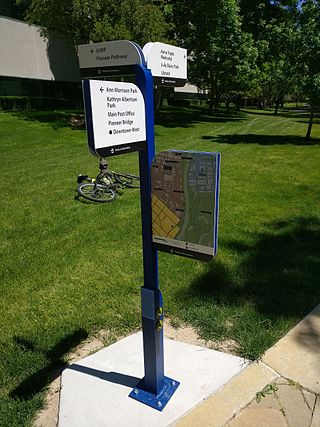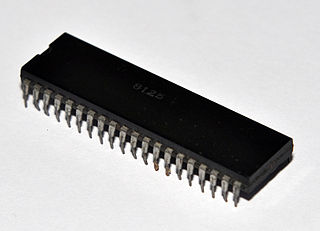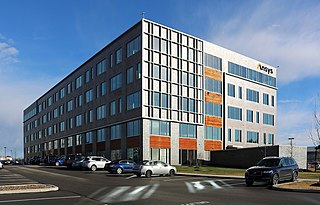Related Research Articles

Computer-aided design (CAD) is the use of computers to aid in the creation, modification, analysis, or optimization of a design. This software is used to increase the productivity of the designer, improve the quality of design, improve communications through documentation, and to create a database for manufacturing. Designs made through CAD software help protect products and inventions when used in patent applications. CAD output is often in the form of electronic files for print, machining, or other manufacturing operations. The terms computer-aided drafting (CAD) and computer-aided design and drafting (CADD) are also used.

A simulation is an imitative representation of a process or system that could exist in the real world. In this broad sense, simulation can often be used interchangeably with model. Sometimes a clear distinction between the two terms is made, in which simulations require the use of models; the model represents the key characteristics or behaviors of the selected system or process, whereas the simulation represents the evolution of the model over time. Another way to distinguish between the terms is to define simulation as experimentation with the help of a model. This definition includes time-independent simulations. Often, computers are used to execute the simulation.

A prototype is an early sample, model, or release of a product built to test a concept or process. It is a term used in a variety of contexts, including semantics, design, electronics, and software programming. A prototype is generally used to evaluate a new design to enhance precision by system analysts and users. Prototyping serves to provide specifications for a real, working system rather than a theoretical one. Physical prototyping has a long history, and paper prototyping and virtual prototyping now extensively complement it. In some design workflow models, creating a prototype is the step between the formalization and the evaluation of an idea.

An application-specific integrated circuit is an integrated circuit (IC) chip customized for a particular use, rather than intended for general-purpose use, such as a chip designed to run in a digital voice recorder or a high-efficiency video codec. Application-specific standard product chips are intermediate between ASICs and industry standard integrated circuits like the 7400 series or the 4000 series. ASIC chips are typically fabricated using metal–oxide–semiconductor (MOS) technology, as MOS integrated circuit chips.

Computer-aided engineering (CAE) is the general usage of technology to aid in tasks related to engineering analysis. Any use of technology to solve or assist engineering issues falls under this umbrella.

A gate array is an approach to the design and manufacture of application-specific integrated circuits (ASICs) using a prefabricated chip with components that are later interconnected into logic devices according to custom order by adding metal interconnect layers in the factory. It was popular during the upheaval in the semiconductor industry in the 1980s, and its usage declined by the end of the 1990s.

In industry, product lifecycle management (PLM) is the process of managing the entire lifecycle of a product from its inception through the engineering, design and manufacture, as well as the service and disposal of manufactured products. PLM integrates people, data, processes, and business systems and provides a product information backbone for companies and their extended enterprises.

Ansys, Inc. is an American multinational company with its headquarters based in Canonsburg, Pennsylvania. It develops and markets CAE/multiphysics engineering simulation software for product design, testing and operation and offers its products and services to customers worldwide.
Virtual engineering (VE) is defined as integrating geometric models and related engineering tools such as analysis, simulation, optimization, and decision making tools, etc., within a computer-generated environment that facilitates multidisciplinary collaborative product development. Virtual engineering shares many characteristics with software engineering, such as the ability to obtain many different results through different implementations.
Digital Prototyping gives conceptual design, engineering, manufacturing, and sales and marketing departments the ability to virtually explore a complete product before it's built. Industrial designers, manufacturers, and engineers use Digital Prototyping to design, iterate, optimize, validate, and visualize their products digitally throughout the product development process. Innovative digital prototypes can be created via CAutoD through intelligent and near-optimal iterations, meeting multiple design objectives, identifying multiple figures of merit, and reducing development gearing and time-to-market. Marketers also use Digital Prototyping to create photorealistic renderings and animations of products prior to manufacturing. Companies often adopt Digital Prototyping with the goal of improving communication between product development stakeholders, getting products to market faster, and facilitating product innovation.
Virtual product development (VPD) is the practice of developing and prototyping products in a completely digital 2D/3D environment. VPD has four main components:

SimulationX is a CAE software application running on Microsoft Windows for the physical simulation of technical systems. It is developed and sold by ESI Group.

TANIQ is a Dutch based company that develops technology for manufacturers to improve the design and production of Reinforced rubber products. The company is a spin-off from the Aerospace department of Delft University of Technology. TANIQ’s expertise is optimizing reinforcement structures of rubber products. Their mission statement is to automate both the design and production process of a large group of industrial rubber products that is still manufactured manually today. Therefore they have developed special software to automate the design of reinforced rubber products. Furthermore, they have developed and supply equipment to automate the production processes. The equipment comprises industrial robots for automated placement of rubber and fiber layers. The goal is to achieve a repeatable high product performance and to reduce material and labor costs.
The ETAS Group is a German company which designs tools for the development of embedded systems for the automotive industry and other sectors of the embedded industry. ETAS is 100-percent subsidiary of Robert Bosch GmbH.

ESI Group provides virtual prototyping software that simulates a product's behavior during testing, manufacturing and real-life use. Engineers in a variety of industries use its software to evaluate the performance of proposed designs in the early phases of the project with the goal of identifying and eliminating potential design flaws.
Pam-Crash is a software package from ESI Group used for crash simulation and the design of occupant safety systems, primarily in the automotive industry. The software enables automotive engineers to simulate the performance of a proposed vehicle design and evaluate the potential for injury to occupants in multiple crash scenarios.
Industrial and production engineering (IPE) is an interdisciplinary engineering discipline that includes manufacturing technology, engineering sciences, management science, and optimization of complex processes, systems, or organizations. It is concerned with the understanding and application of engineering procedures in manufacturing processes and production methods. Industrial engineering dates back all the way to the industrial revolution, initiated in 1700s by Sir Adam Smith, Henry Ford, Eli Whitney, Frank Gilbreth and Lilian Gilbreth, Henry Gantt, F.W. Taylor, etc. After the 1970s, industrial and production engineering developed worldwide and started to widely use automation and robotics. Industrial and production engineering includes three areas: Mechanical engineering, industrial engineering, and management science.
A digital twin is a digital model of an intended or actual real-world physical product, system, or process that serves as the effectively indistinguishable digital counterpart of it for practical purposes, such as simulation, integration, testing, monitoring, and maintenance. The digital twin has been intended from its initial introduction to be the underlying premise for Product Lifecycle Management and exists throughout the entire lifecycle of the physical entity it represents. Since information is granular, the digital twin representation is determined by the value-based use cases it is created to implement. The digital twin can and does often exist before there is a physical entity, as for example with virtual prototyping. The use of a digital twin in the creation phase allows the intended entity's entire lifecycle to be modeled and simulated. A digital twin of an existing entity may be used in real-time and regularly synchronized with the corresponding physical system.
Digital manufacturing is an integrated approach to manufacturing that is centered around a computer system. The transition to digital manufacturing has become more popular with the rise in the quantity and quality of computer systems in manufacturing plants. As more automated tools have become used in manufacturing plants it has become necessary to model, simulate, and analyze all of the machines, tooling, and input materials in order to optimize the manufacturing process. Overall, digital manufacturing can be seen sharing the same goals as computer-integrated manufacturing (CIM), flexible manufacturing, lean manufacturing, and design for manufacturability (DFM). The main difference is that digital manufacturing was evolved for use in the computerized world.
Predictive engineering analytics (PEA) is a development approach for the manufacturing industry that helps with the design of complex products. It concerns the introduction of new software tools, the integration between those, and a refinement of simulation and testing processes to improve collaboration between analysis teams that handle different applications. This is combined with intelligent reporting and data analytics. The objective is to let simulation drive the design, to predict product behavior rather than to react on issues which may arise, and to install a process that lets design continue after product delivery.
References
- ↑ Schaaf, James C. Jr.; Thompson, Faye Lynn (1997). Systems Concept Development with Virtual Prototyping. 29th conference on Winter simulation. pp. 941–947. CiteSeerX 10.1.1.74.2308 .
- ↑ LaCourse, Dan (May 1, 2003). "Virtual Prototyping Pays Off". Cadalyst Magazine.
- ↑ Ghazaleh, Tim (November 1, 2004). "Virtual Prototyping" (PDF). Printed Circuit Design & Manufacture Magazine.
- ↑ Otto, Von Thomas (July–August 2010). "Endlich umfassend simulieren". Digital Engineering. 6/10. Archived from the original on 2011-01-02. Retrieved 2010-10-05.
- ↑ Fouad El Khaldi, Raymond Ni, Pierre Culiere, Peter Ullrich, Carlos Terres Aboitiz. "Recent Integration Achievements in Virtual Prototyping for the Automo bile Industry". ESI-group.com; ESI Group. Presented May 31, 2010, FISITA.
- ↑ Aberdeen Group (October 2006). "Simulation-Driven Design Benchmark Report: Getting It Right the First Time". p. i. October 2006. Retrieved 2010-08-25.
- ↑ Aberdeen, p. 5.
- ↑ "Fisker reduces number of prototypes, cuts time to market with Virtual Performance Solution," Automotive Engineering International, January, 2013.
- ↑ Matt Richter, "Simulation techniques help cool the calibration head for the world's fastest real-time oscilloscope," R&D Magazine, October, 2013.
- ↑ "A Better Way to Make Medical Instruments Come Clean," Medical Design Technology, October, 2013.
- ↑ Lista Studio, "Lista Studio's Case Studies".